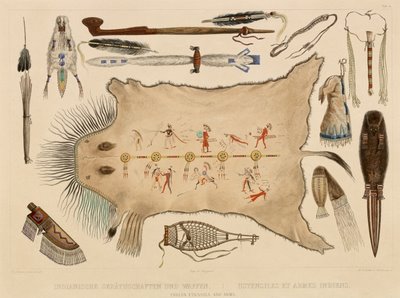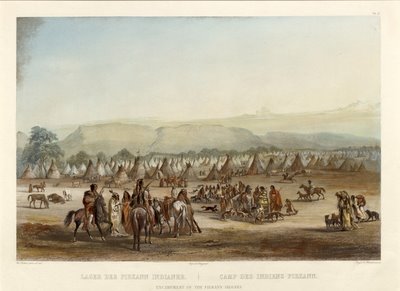Karl Bodmer (1809-1893) was a Swiss artist hired by the German naturalist Prince Maximilian zu Wied-Neuwied to travel with him on an expedition across the American west and up the Missouri river.
Prince Maximilian wanted "to bring along a draftsman who [..] must be a landscape painter but also be able to depict figures correctly and accurately, especially the Indians."
It seems the Prince was satisfied from the outset: "He is a lively, very good man and companion, seems well educated and is very pleasant and suitable for me; I am glad I picked him. He makes no demands and in diligence, he is never lacking."
And even moreso with hindsight: "If I could only show you, my dear [brother] August, Mr. Bodmer's portfolio. How many times you would exclaim: 'Oh, excellent! Beautiful! Beautiful!' "
Their travels took place between 1832 and 1834 and over the following years Bodmer personally directed the creation of about 80 aquatint plates that would accompany the Prince's commentary. 'Travels in the Interior of North America' was published in Europe in various formats between 1839 and 1843.
It was not until after WWII that the complete body of work produced by Bodmer during the American journey was discovered. Hundreds of sketches and watercolour paintings were purchased from Prince Maximilian's descendents and the majority are now housed at the Joslyn Gallery in Nebraska.
"The significance of Bodmer's illustrations cannot be overemphasized. Few explorers had ever engaged professional artists to document their journeys. Maximilian insisted that the European-trained Bodmer paint with strict attention to detail. The resulting watercolors, upon which the published aquatints were based, had a photographic accuracy that was unequaled and which have subsequently proved invaluable to historians and ethnologists. For over one-hundred-fifty years Bodmer's aquatints have remained the major source of information regarding Plains Indian culture."
- The images above come from a University of Utah collection of both black and white and colour prints from 'Travels in the Interior of North America'.
- An original sketchbook (I actually posted an image from here previously) by Bodmer is on display at the excellent French Drawings website (Bodmer eventually became a French citizen, concentrating on book illustration in later life).
- The Maximilian-Bodmer Expedition at Joslyn Art Museum.
- 'Karl Bodmer's Visionary Years' - an essay by Mary Terrence McKay.
- 'Karl Bodmer's North American Prints' Edited by Brandon K. Ruud and published in 2005 is by all accounts the definitive compilation and analysis of Bodmer's American artistic legacy (2 inches thick and weighing 5 pounds, it includes 431 illustrations).



























No comments :
Post a Comment
Comments are all moderated so don't waste your time spamming: they will never show up.
If you include ANY links that aren't pertinent to the blog post or discussion they will be deleted and a rash will break out in your underwear.
Also: please play the ball and not the person.
Note: only a member of this blog may post a comment.